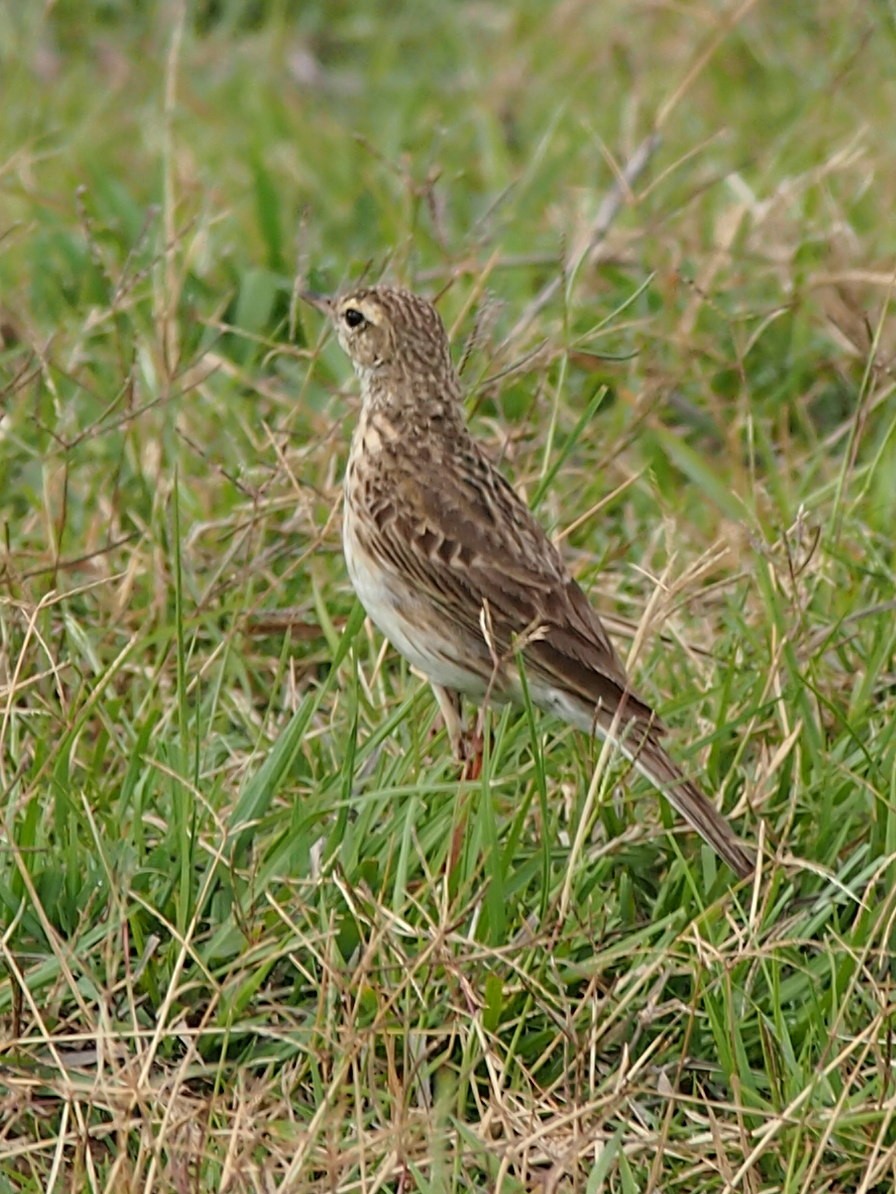Richard's Pipit
A species of Pipits Scientific name : Anthus richardi Genus : Pipits
Richard's Pipit, A species of Pipits
Botanical name: Anthus richardi
Genus: Pipits
Content
Description General Info
 Photo By Mark Marathon , used under CC-BY-SA-3.0 /Cropped and compressed from original
Photo By Mark Marathon , used under CC-BY-SA-3.0 /Cropped and compressed from original Description
This is a large pipit, 17–20 cm in length, with a weight of 25–36 g and a wingspan of 29 to 33 cm. It is a slender bird which often stands very upright. It has long yellow-brown legs, a long tail with white outer-feathers and a long dark bill with a yellowish base to the lower mandible. The hindclaw is long and fairly straight. It is an undistinguished-looking species on the ground, mainly brown above and pale below. There are dark streaks on the upperparts and breast while the belly and flanks are plain. The face is strongly marked with pale lores and supercilium and dark eyestripe, moustachial stripe and malar stripe. There are two wingbars formed by pale tips to the wing-coverts. There is some variation between the different subspecies. A. r. sinensis is slightly smaller than the nominate race with less streaking above. A. r. centralasiae is larger with more sand-coloured upperparts. A. r. dauricus has more streaking above. Its flight is strong and undulating, and it gives a characteristic explosive "shreep" call, somewhat similar to the chirp of a house sparrow. The song is a repeated series of monotonous buzzy notes given in an undulating song-flight. Some care must be taken to distinguish this from other large pipits which winter or are resident in the area, such as Blyth's pipit and paddyfield pipit. Blyth's pipit has a shorter bill, legs and tail, a shorter and more curved hindclaw, less white on the tail and more streaking on the upperparts. In adult birds, the median wing-coverts have blunt-ended dark centres whereas in Richard's pipit the dark centres become pointed towards the tip of the feather. The call of Blyth's pipit call is quieter and less harsh. Paddyfield pipit is smaller than Richard's pipit with a shorter bill and tail, less streaking on the breast and a quieter call. 
Size
18 cm
Colors
Brown
Black
Yellow
Gray
White
Life Expectancy
5 years
Nest Placement
Ground
Feeding Habits
Richard's Pipit primarily consumes insects, foraging on the ground and catching flying prey midair. Occasionally, it eats seeds. Its diet and hunting techniques reflect its adaptation for terrestrial feeding.
Habitat
Richard's Pipit typically inhabits open landscapes, encompassing steppe grasslands, agricultural terrains like paddy fields and stubble fields, as well as the peripheries of reservoirs and marshy areas. This bird species favors locations generally below 1800 meters elevation, but during migration, it has been recorded at extreme altitudes up to 6300 meters on Mt. Everest. Geographically, its habitats span vast regions from Southern Siberia to South-east Asia and – during migration – extending to parts of Europe, the Middle East, and North Africa.
Dite type
Insectivorous
General Info
Feeding Habits
Bird food type
Behavior
It is a bird of open country, particularly flat lowland areas. It inhabits grassland, steppe and cultivated land, preferring more fertile, moist habitats. In Europe it is most often recorded on headlands and islands. It occurs alone or in small groups. Like other pipits, this species is insectivorous. It mainly feeds on the ground and will also make short flights to catch flying insects. A few seeds are also eaten. The nest is made of grass or moss and is built on the ground under a grass tussock. 
Distribution Area
Richard's pipit breeds in southern Siberia, Mongolia, parts of Central Asia and in northern, central and eastern China. It migrates south to winter in the Indian subcontinent and South-east Asia with records as far south as Sri Lanka, Singapore and northern Borneo. It is a scarce passage migrant in Korea and Japan. A small part of the population regularly moves west in autumn and birds have been recorded from most countries in Europe, the Middle East and North Africa. It is seen annually between September and November at coastal watchpoints in areas such as Britain, the Netherlands and Scandinavia with occasional birds appearing in spring. A few overwinter in countries like Spain, Portugal, Italy and Morocco. 
Species Status
Not globally threatened.
Scientific Classification
Phylum
Chordates Class
Birds Order
Perching birds Family
Wagtails Genus
Pipits Species
Richard's Pipit